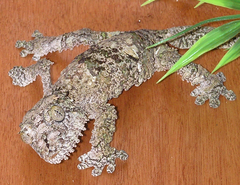Uroplatus: Difference between revisions
No edit summary |
No edit summary |
||
| Line 17: | Line 17: | ||
The ''Uroplatus'' are [[nocturnal]] and [[arboreal]]. They range in size from about 12 inches (''U. giganteus'') to 2.5 inches (''U. ebanaui and U. phantasticus''). They spend most of the daylight hours time hanging vertically on tree trunks, head down, resting. During the night, they will venture from their daylight resting spots, and go off in search of prey. They are all [[insectivores]]. |
The ''Uroplatus'' are [[nocturnal]] and [[arboreal]]. They range in size from about 12 inches (''U. giganteus'') to 2.5 inches (''U. ebanaui and U. phantasticus''). They spend most of the daylight hours time hanging vertically on tree trunks, head down, resting. During the night, they will venture from their daylight resting spots, and go off in search of prey. They are all [[insectivores]]. |
||
They all have coloration developed as [[camouflage]], most being grayish brown to black or greenish brown with various markings meant to resemble [[tree]] bark. There are two variations of this camouflage: leaf form, and bark form. The leaf form is present on only two species, ''U. phantasticus'' and ''U. ebanaui'', which are also the two smallest species. All other forms blend in well with tree bark upon which they rest during the day. Some of these treebark forms have developed a flap of skin, running the length of their bodies, known as a ''dermal flap'', which they lay against the tree during the day, scattering shadows, and making their outline practically invisible. |
They all have coloration developed as [[camouflage]], most being grayish brown to black or greenish brown with various markings meant to resemble [[tree]] bark. There are two variations of this camouflage: leaf form, and bark form. The leaf form is present on only two species, ''U. phantasticus'' and ''U. ebanaui'', which are also the two smallest species. All other forms blend in well with tree bark upon which they rest during the day. Some of these treebark forms have developed a flap of skin, running the length of their bodies, known as a ''dermal flap'', which they lay against the tree during the day, scattering shadows, and making their outline practically invisible. |
||
[[Image:DSCF4553close.JPG|thumb|left|Uroplatus Fimbriatus have some of the most unusual eyes in the animal kingdom. (Photo By J.W. Connelly)|285px]] |
|||
''Uroplatus'' are found in the [[herpetology]] and [[pet]] trade, but rarely. Most are threatened due to [[deforestation]] and habitat loss, therefore more are taken out of the wild in areas that are being preped for being cut down. |
''Uroplatus'' are found in the [[herpetology]] and [[pet]] trade, but rarely. Most are threatened due to [[deforestation]] and habitat loss, therefore more are taken out of the wild in areas that are being preped for being cut down. |
||
Revision as of 10:25, 1 January 2007
| Uroplatus | |
|---|---|

| |
| Uroplatus sikorae | |
| Scientific classification | |
| Kingdom: | |
| Phylum: | |
| Class: | |
| Order: | |
| Suborder: | |
| Family: | |
| Genus: | Uroplatus
|
Geckos of the genus Uroplatus are commonly referred to as flat or leaf tailed geckos. All of the species of this genus are found in primary and secondary forests on the island of Madagascar. They are endemic to the island, and found nowhere else on earth.
The Uroplatus are nocturnal and arboreal. They range in size from about 12 inches (U. giganteus) to 2.5 inches (U. ebanaui and U. phantasticus). They spend most of the daylight hours time hanging vertically on tree trunks, head down, resting. During the night, they will venture from their daylight resting spots, and go off in search of prey. They are all insectivores.
They all have coloration developed as camouflage, most being grayish brown to black or greenish brown with various markings meant to resemble tree bark. There are two variations of this camouflage: leaf form, and bark form. The leaf form is present on only two species, U. phantasticus and U. ebanaui, which are also the two smallest species. All other forms blend in well with tree bark upon which they rest during the day. Some of these treebark forms have developed a flap of skin, running the length of their bodies, known as a dermal flap, which they lay against the tree during the day, scattering shadows, and making their outline practically invisible.
Uroplatus are found in the herpetology and pet trade, but rarely. Most are threatened due to deforestation and habitat loss, therefore more are taken out of the wild in areas that are being preped for being cut down.
During their breeding season, female Uroplatus lay from 2-4 eggs depending on species and conditions.
